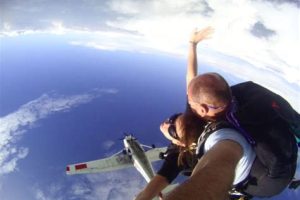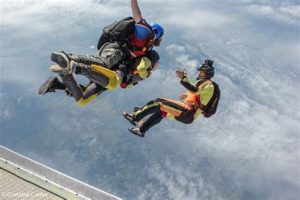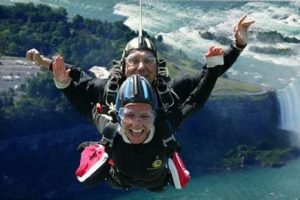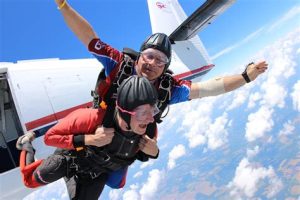Table of Contents
Looking to experience the thrill of tandem skydiving? Learn about the maximum weight limits for tandem jumps and find out whether you meet the requirements. Discover the exhilaration of soaring through the skies as you conquer your fears alongside a certified skydiving instructor. Book your tandem skydiving adventure today!
Are you an adventure seeker looking to take your adrenaline rush to new heights? If so, tandem skydiving might be just the thrill you’ve been searching for. But before you take the leap, it’s important to familiarize yourself with the maximum weight restrictions for tandem skydiving. By following these guidelines, you can ensure a safe and exhilarating experience that will leave you with memories to last a lifetime. So, let’s dive right in and discover the crucial details regarding the maximum weight for tandem skydiving.
Introduction
Welcome to the world of tandem skydiving! If you’re considering taking the leap and experiencing the exhilarating thrill of freefall, you may have some questions about the maximum weight limit for tandem skydiving. In this article, we will guide you through the instructions and provide all the information you need to know.
Understanding Tandem Skydiving
Tandem skydiving is a popular form of skydiving where a student skydiver is attached to an experienced instructor via a harness system. This allows beginners to experience the thrill of skydiving without the need for extensive training or certification. It’s an incredible adventure that offers a unique perspective of the world from thousands of feet above the ground!
Importance of Weight Limits
Weight limits are crucial in tandem skydiving as they ensure the safety of both the student and instructor. The combined weight of the two individuals affects the deployment of the parachute, the speed of descent, and the overall control during the jump. Adhering to weight limits helps maintain stability and control, ensuring a safe and enjoyable experience for everyone involved.
Typical Weight Limits
The weight limits for tandem skydiving can vary depending on the drop zone and equipment used. However, a common guideline is that the maximum weight for a tandem skydiver is usually around 220-230 pounds (100-105 kilograms). Some drop zones may have lower limits due to specific equipment capabilities or safety regulations.
Factors Influencing Weight Limits
Several factors can affect weight limits in tandem skydiving:
Equipment Strength
The strength and durability of the tandem skydiving equipment play a significant role in determining weight limits. The gear must be capable of supporting the combined weight of the student and instructor throughout the jump, including the parachute deployment and landing.
Altitude and Temperature
Altitude and temperature can impact the performance of the parachute and the overall experience of the jump. Higher altitudes and colder temperatures may require adjustments to weight limits to account for variables such as air density and wind resistance.
Experience Level of Instructors
The experience level and skill of the instructor can also influence the weight limits. Highly experienced instructors may be able to accommodate slightly higher weights while maintaining control and safety.
Additional Considerations
While weight limits are essential, there are a few additional considerations to keep in mind:
Physical Fitness
It’s important for tandem skydivers to be in reasonably good physical health. The harness system and the forces experienced during freefall can put some strain on the body, so individuals with pre-existing medical conditions or injuries may need to consult with their doctor before participating.
Size and Fit
The size and fit of the harness should also be taken into account. Drop zones typically provide a range of harness sizes, but individuals at the upper end of the weight limit may experience limitations in availability or require custom arrangements.
Conclusion
Tandem skydiving is an incredible adventure that offers an adrenaline rush like no other. While weight limits are in place to ensure safety, it’s essential to remember that they exist for a reason. By adhering to these limits and considering the additional factors mentioned, you can have a safe and unforgettable tandem skydiving experience. So, get ready to soar through the sky and create memories that will last a lifetime!
Max Weight for Tandem Skydiving – Usage Instructions
Safety Precautions
1. Always prioritize safety: Before participating in tandem skydiving, it is important to ensure that you meet the required weight restrictions. Failure to comply with these limitations can compromise the safety of both the diver and instructor.
2. Follow professional guidance: Listen to the instructions given by the licensed tandem skydiving instructor who will assess your weight and provide you with the necessary guidelines for a safe and enjoyable experience.
3. Understand the importance of weight limits: Strict weight restrictions are set for tandem skydiving to ensure proper equipment functioning, parachute deployment, and overall stability during the freefall and landing phases.
Weight Limitation Guidelines
1. Weight restrictions may vary: Different skydiving centers or facilities may have varying weight limits due to factors such as parachute size, weather conditions, and aircraft capacity. Always consult with the specific facility you plan to visit for the most accurate weight restrictions.
2. Common weight limitations: The generally accepted weight limit for tandem skydiving is around 220-240 pounds (100-110 kilograms). However, it is essential to note that these limits may vary, especially for individuals who are particularly tall or short.
3. Factors affecting weight limitations: The tandem skydiving weight restrictions are determined by various factors, including but not limited to, the strength of the instructor, harness limitations, parachute capabilities, and overall equipment specifications.
Safety Considerations for Exceeding Weight Limits
1. Understand the risks: Exceeding the prescribed weight limits for tandem skydiving can compromise the safety of the entire jump. It can hamper parachute deployment, control during freefall, and increase the chances of injury upon landing.
2. Potential exclusions: In cases where individuals exceed the recommended weight limitations, some skydiving centers may offer alternative options such as advanced training programs or solo jumps, depending on their policies and the individual’s physical fitness assessment.
3. Communicate transparently: It is crucial to be upfront and honest about your weight during the booking process to ensure every precaution is taken to provide a safe and enjoyable skydiving experience.
Booking Considerations
1. Provide accurate weight information: While booking a tandem skydiving session, ensure you provide your accurate weight details to the skydiving center. Calculate your weight wearing any necessary equipment, such as goggles or harness, to obtain the most precise measurement.
2. Consult the skydiving center: If you are unsure about whether you meet the weight requirements, contact the skydiving facility in advance to discuss your situation and receive guidance on the available options.
3. Plan ahead: Keep in mind that if you do not meet the weight restrictions, you may need to postpone your tandem skydiving adventure until you reach a weight within the specified limits.
Importance of Weight Distribution
1. Maintaining balance: Proper weight distribution between the tandem skydiving instructor and the participant is vital for a controlled and stable descent. Balancing the weight effectively allows for better maneuverability during the dive and ensures a safer landing experience.
2. Instructor considerations: Tandem skydiving instructors are trained to manage different weight distributions and will adjust their harnesses accordingly to maintain balance and stability throughout the jump.
3. Clear communication: Communicate openly with your instructor about any concerns regarding weight distribution during the briefing session to ensure both parties are comfortable and confident before taking off.
Equipment Limitations
1. Equipment specifications: The tandem skydiving equipment, including the parachute and harness, is designed to meet a specific weight capacity. Exceeding these limits can put excessive strain on the equipment, compromising its performance and safety.
2. Check manufacturer guidelines: Refer to the manufacturer’s guidelines for the specific equipment being used during your tandem skydiving experience to determine the weight limitations. These guidelines ensure the longevity and proper functioning of the equipment.
3. Instructor’s discretion: The tandem skydiving instructor has the final say on whether a participant can safely proceed with the jump, taking into consideration the limitations of the equipment and personal experience in handling different weight scenarios.
Additional Considerations
1. Physical fitness: While weight is a crucial factor in tandem skydiving, maintaining good physical fitness is equally important. Discuss any health concerns or physical limitations with the instructor to ensure a safe and comfortable skydiving experience.
2. Clothing considerations: Consider wearing appropriate clothing that allows for ease of movement and fits comfortably under the harness, ensuring it does not affect weight distribution or restrict movement during the jump.
3. Know your limits: If you have any doubts about your ability to undertake a tandem skydiving experience due to weight or physical fitness concerns, it is advisable to consult a healthcare professional before proceeding.
Enjoying the Experience
1. Trust the professionals: Remember that tandem skydiving instructors are well-trained professionals who prioritize your safety and enjoyment. Trust their expertise and guidance throughout the entire process.
2. Relish the moment: Once every precaution has been taken regarding weight limits and safety measures, simply relax, soak in the exhilarating experience, and enjoy the incredible sensation of freefalling through the sky.
3. Cherish memories: Capture the memories of this once-in-a-lifetime experience by documenting it through photos or videos provided by the skydiving center, so you can relive the thrill for years to come.
Max Weight For Tandem Skydiving:
- Introduction:
- Importance of Max Weight Limit:
- Max Weight Limit:
- Weight Verification Process:
- Weight Restrictions:
- Conclusion:
Hello and welcome to our tandem skydiving center! We are thrilled that you have chosen to experience the exhilarating adventure of a tandem skydive. As you prepare for your jump, it is important to note the maximum weight limit for tandem skydiving.
Ensuring your safety during the skydive is our top priority. That’s why we have established a maximum weight limit for tandem skydiving. This limit is in place to ensure that the equipment can handle the weight and maneuver safely during the jump. It also ensures that the tandem instructors can maintain proper control throughout the entire skydiving experience.
The maximum weight limit for tandem skydiving at our center is 220 pounds (100 kilograms). It is important to adhere to this limit for the safety of both the participant and the instructor. Exceeding this weight limit may compromise the effectiveness of the parachute system and increase the risk of injury during landing.
Prior to your skydive, our team will conduct a weight verification process to ensure that you meet the maximum weight limit. This process involves stepping onto a specialized scale to accurately measure your weight. It is important to provide honest and accurate information during this verification to guarantee a safe and enjoyable skydiving experience.
In addition to the maximum weight limit, there may be certain restrictions based on the individual’s height, build, and physical fitness. Our experienced instructors will evaluate these factors on a case-by-case basis to ensure that every participant can safely participate in tandem skydiving.
We hope this information has helped clarify the importance of the maximum weight limit for tandem skydiving. Safety is our utmost concern, and adhering to these guidelines will guarantee a thrilling yet secure skydiving experience. If you have any further questions or concerns, please don’t hesitate to reach out to our team. We look forward to sharing the skydiving adventure with you!
Thank you for visiting our blog and taking the time to read about the maximum weight for tandem skydiving. We understand that this topic is of great importance to many individuals who are considering experiencing the thrill of skydiving, and we are here to provide you with the necessary information and guidelines to ensure your safety and enjoyment.
First and foremost, it is essential to note that the maximum weight limit for tandem skydiving varies depending on the drop zone and the equipment being used. In general, the weight limit ranges from 200 to 240 pounds (90 to 109 kilograms). This limit is in place to ensure the safety of both the participant and the instructor, as well as to comply with the guidelines set by the parachute manufacturers.
Transitioning to the next point, exceeding the weight limit can have serious consequences. The equipment used for tandem skydiving is designed to accommodate a specific weight range, and exceeding this limit can put excessive strain on the gear, potentially compromising its integrity. This, in turn, increases the risk of accidents and injuries during the jump or landing. Therefore, it is crucial to respect and adhere to the weight restrictions set by the drop zone.
In conclusion, we highly recommend that individuals interested in tandem skydiving check with their chosen drop zone about the specific weight limit in place. It is essential to provide accurate weight information when making a reservation to ensure the appropriate gear and instructor are assigned for your safety and comfort. Remember, tandem skydiving is an incredible experience that should be enjoyed responsibly, and respecting the weight limit is an important part of that responsibility. If you have any further questions or concerns regarding this matter, please do not hesitate to reach out to the drop zone directly for clarification.
Once again, thank you for visiting our blog, and we hope that this article has provided you with valuable information regarding the maximum weight for tandem skydiving. We wish you an exhilarating and safe skydiving adventure!
.
People Also Ask About Max Weight For Tandem Skydiving:
-
What is the maximum weight limit for tandem skydiving?
The maximum weight limit for tandem skydiving varies depending on the drop zone and equipment being used. Generally, it ranges between 200 to 240 pounds (90 to 109 kilograms). However, these limits can differ, so it’s best to check with the specific skydiving center you plan to jump with.
-
Why is there a weight limit for tandem skydiving?
The weight limit for tandem skydiving exists for safety reasons. It ensures that the parachute system and harness can safely handle the combined weight of the instructor and the participant. Exceeding the weight limit could compromise the equipment’s functionality and increase the risk of injury for both individuals.
-
Can someone slightly over the weight limit still skydive?
In some cases, individuals slightly over the weight limit may still be able to skydive, but it depends on the policies of the specific skydiving center. Some centers may have additional equipment or restrictions in place to accommodate slightly heavier participants. It’s important to contact the center directly and discuss your situation with them.
-
Is there a minimum weight requirement for tandem skydiving?
Yes, most skydiving centers have a minimum weight requirement, typically around 100 to 120 pounds (45 to 54 kilograms). This requirement ensures that there is enough weight for a safe and controlled descent. It’s important to meet the minimum weight requirement to ensure a successful skydiving experience.
-
Can weight restrictions be waived with a doctor’s note?
While policies may vary, in general, weight restrictions for tandem skydiving cannot be waived with a doctor’s note. The weight limits are put in place to ensure the safety of all participants and are typically non-negotiable. It is best to contact the skydiving center directly to discuss any specific concerns or considerations before making a reservation.
Remember, it’s essential to consult with your chosen skydiving center to get accurate and up-to-date information regarding their weight restrictions and requirements.






